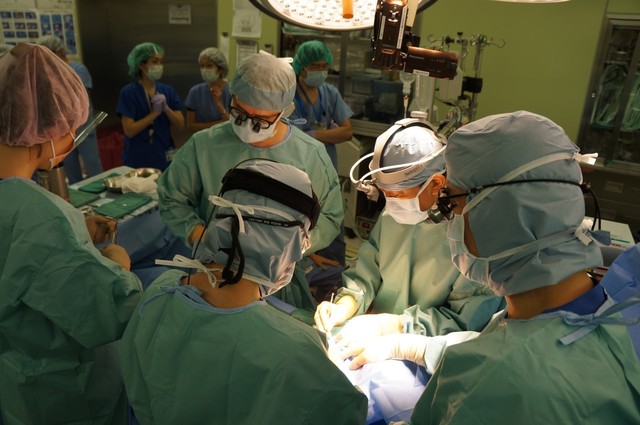【背景】左小開胸アプローチでのCABG(MICS-CABG)は胸骨骨髄炎が発生しない、早期の退院、社会復帰が可能という点で従来の正中アプローチに比較して優れており、カテーテル治療が進化して適応拡大していく中でCABGがその存在意義を高めるためには普及させていく必要のある術式である。この術式において、左内胸動脈(LITA)の採取が確実にできるかどうかが、適応選択における重要な一因子であり、まずは慣れた正中アプローチに近い視野、操作性からLITA採取が可能な直視下が基本である。
【目的】左小開胸アプローチからの直視下でのLITA採取について、正中切開からの採取と比較しそのラーニングカーブについても検討する。
【方法】当院で左小開胸アプローチからの冠動脈バイパス術を導入した2017年10月から2021年2月までの間に実施した冠動脈バイパス術80例のうち、MICS-CABGは30例(38%)であった。左小開胸アプローチ症例は1枝バイパスが18例(60%)を占め、2枝以上の多枝バイパスが12例(40%)で、全症例で左内胸動脈を使用。同一術者におけるLITA採取時間、LITA―LAD流量およびPI値を正中アプローチと左開胸アプローチで比較した。
【結果】平均バイパス枝数は左開胸1.7枝、正中3.2枝で有意に左開胸で少なかった。LITA―LADの術後造影ではすべて開存が確認されたが、うち左開胸導入早期の1例で止血クリップを起点とした屈曲・狭窄症例を認めた。皮膚切開からTarget血管の確認を経てLITAを剥離し終わるまでの時間は正中アプローチ平均62.3(中央値60)分に対して、左開胸89.0(中央値80分)と有意(P=0.006)に左開胸で長く、ラーニングカーブによる時間短縮傾向はみられなかった。また流量は正中49ml/分、左開胸31ml/分と有意(P=0.0005)に少なかったがPI値に有意差はなかった(2.2vs3.1)。術後の疼痛に関しては、肋間神経ブロックを併用することで、鎮痛薬内服のみの症例に比較して少ない傾向にあったが正中アプローチに比較して強い傾向にあった。
【考察】正中と比較してLITA採取時間は20分以上長く、流量も少なかったが、PI値に有意差がなく、これは左開胸症例が左前下行枝閉塞の1枝病変が多く、側副血行の発達や陳旧性梗塞に伴う前下行枝の内腔狭小化などの変化を来たしている症例が多いことが関連していると考えられた。MICS-CABG導入・普及が優先される現段階においては、慣れた正中アプローチ近い視野、操作性での直視下LITA採取が基本である。末梢吻合において必要な皮膚切開が変わらないのであれば、保険手技量の加算が認められない現時点では直視下LITA採取が基本である。末梢吻合も完全鏡視下での実施が可能となれば、次のエキスパート段階である完全鏡視下手術が目標となる。
【結語】MICS-CABGにおけるLITA採取に関しては直視下採取によってまずは普及を促進する段階である。
One of the limitation for the indication of CABG through left mini-thoracotomy, MICS-CABG, is the difficulty of harvesting the left internal mammary artery, ‘LITA’. To propagate MICS-CABG which attract cardiologists who are making progress in endovascular coronary intervention, the harvesting LITA through the direct vision is the first step. Our facility conceive the lateral thoracotomy is a standard approach and more than 30% (30/80) of the CABG cases were operated with this approach, which contains the direct vision – LITA harvesting in these three years. 60%(18/30) were single revasculization with left internal mammary artery to left anterior descending artery, and the other 40%(12/30) were multiple, which were all patent in postoperative study. The mean harvesting time of LITA was about 20 minutes longer, the flow volume of LITA anastomosis was smaller and wound pain was stronger in MICS series compared with conventional median approach group, but staying time in hospital was shorter with less postoperative complication. Because it is crucial to expand the indication for less invasive coronary surgery, the direct vision harvesting of LITA is preferable to establish MICS-CABG in each facilities.
【目的】左小開胸アプローチからの直視下でのLITA採取について、正中切開からの採取と比較しそのラーニングカーブについても検討する。
【方法】当院で左小開胸アプローチからの冠動脈バイパス術を導入した2017年10月から2021年2月までの間に実施した冠動脈バイパス術80例のうち、MICS-CABGは30例(38%)であった。左小開胸アプローチ症例は1枝バイパスが18例(60%)を占め、2枝以上の多枝バイパスが12例(40%)で、全症例で左内胸動脈を使用。同一術者におけるLITA採取時間、LITA―LAD流量およびPI値を正中アプローチと左開胸アプローチで比較した。
【結果】平均バイパス枝数は左開胸1.7枝、正中3.2枝で有意に左開胸で少なかった。LITA―LADの術後造影ではすべて開存が確認されたが、うち左開胸導入早期の1例で止血クリップを起点とした屈曲・狭窄症例を認めた。皮膚切開からTarget血管の確認を経てLITAを剥離し終わるまでの時間は正中アプローチ平均62.3(中央値60)分に対して、左開胸89.0(中央値80分)と有意(P=0.006)に左開胸で長く、ラーニングカーブによる時間短縮傾向はみられなかった。また流量は正中49ml/分、左開胸31ml/分と有意(P=0.0005)に少なかったがPI値に有意差はなかった(2.2vs3.1)。術後の疼痛に関しては、肋間神経ブロックを併用することで、鎮痛薬内服のみの症例に比較して少ない傾向にあったが正中アプローチに比較して強い傾向にあった。
【考察】正中と比較してLITA採取時間は20分以上長く、流量も少なかったが、PI値に有意差がなく、これは左開胸症例が左前下行枝閉塞の1枝病変が多く、側副血行の発達や陳旧性梗塞に伴う前下行枝の内腔狭小化などの変化を来たしている症例が多いことが関連していると考えられた。MICS-CABG導入・普及が優先される現段階においては、慣れた正中アプローチ近い視野、操作性での直視下LITA採取が基本である。末梢吻合において必要な皮膚切開が変わらないのであれば、保険手技量の加算が認められない現時点では直視下LITA採取が基本である。末梢吻合も完全鏡視下での実施が可能となれば、次のエキスパート段階である完全鏡視下手術が目標となる。
【結語】MICS-CABGにおけるLITA採取に関しては直視下採取によってまずは普及を促進する段階である。
One of the limitation for the indication of CABG through left mini-thoracotomy, MICS-CABG, is the difficulty of harvesting the left internal mammary artery, ‘LITA’. To propagate MICS-CABG which attract cardiologists who are making progress in endovascular coronary intervention, the harvesting LITA through the direct vision is the first step. Our facility conceive the lateral thoracotomy is a standard approach and more than 30% (30/80) of the CABG cases were operated with this approach, which contains the direct vision – LITA harvesting in these three years. 60%(18/30) were single revasculization with left internal mammary artery to left anterior descending artery, and the other 40%(12/30) were multiple, which were all patent in postoperative study. The mean harvesting time of LITA was about 20 minutes longer, the flow volume of LITA anastomosis was smaller and wound pain was stronger in MICS series compared with conventional median approach group, but staying time in hospital was shorter with less postoperative complication. Because it is crucial to expand the indication for less invasive coronary surgery, the direct vision harvesting of LITA is preferable to establish MICS-CABG in each facilities.

















